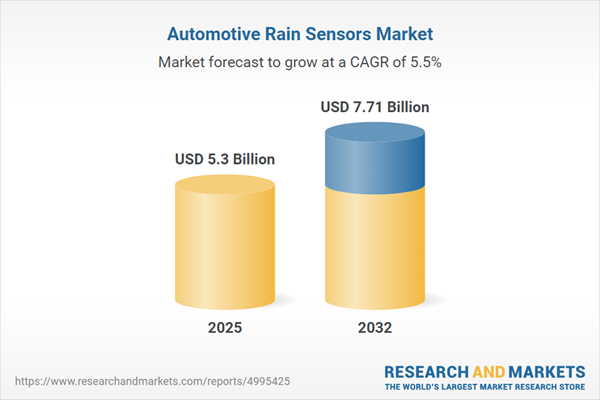Speak directly to the analyst to clarify any post sales queries you may have.
The automotive rain sensors market represents a pivotal innovation area for industry leaders committed to automation, compliance, and vehicle safety. Senior executives seeking to optimize competitive strategy must navigate evolving technology integration and adaptable operational models.
Market Snapshot: Automotive Rain Sensors Market
In 2024, the global automotive rain sensors market reached USD 5.02 billion, with projected growth to USD 5.30 billion by 2025 and anticipated expansion to USD 7.71 billion by 2032, reflecting a CAGR of 5.50%. This trajectory is propelled by rising adoption of advanced driver assistance systems (ADAS), greater vehicle automation, and international pressures for regulatory compliance. As OEMs and suppliers actively recalibrate, businesses are aligning operational strategies to leverage regional strengths within increasingly complex regulatory settings.
Scope & Segmentation
This report delivers practical insights to assist senior leadership in decision-making and strategic assessment, clarified by comprehensive analysis of the automotive rain sensors market structure. Segment relevance extends to both direct integration for new vehicle rollouts and aftermarket upgrades, supporting dynamic competitive needs.
- Application: Monitors integration trends across original equipment manufacturers and retrofitting initiatives, with a focus on enabling streamlined adoption for new model launches and fleet upgrades.
- Sensor Type: Compares mechanical and optical sensor technologies, evaluating variations in detection accuracy, system response times, and adaptability within multifaceted vehicle architectures.
- Vehicle Type: Explores sensor adoption across the spectrum of passenger vehicles, commercial fleets, and specialized automotive classes to inform product and portfolio diversification.
- Material: Considers the implications of ceramic versus plastic sensor bases on device resilience, operational reliability, and manufacturing cost-effectiveness for broader implementation.
- Regional Coverage: Highlights market and compliance developments across major regions, including the Americas, Europe, Asia-Pacific, and the Middle East & Africa, indicating the need for flexible strategies in response to shifting regulatory and operational frameworks.
- Key Companies: Examines strategic roles and innovation initiatives of major industry players such as Robert Bosch GmbH, Continental AG, DENSO Corporation, Valeo SA, Gentex Corporation, HELLA GmbH & Co. KGaA, Aisin Seiki Co., Ltd., Mando Corporation, Marelli Holdings, Inc., and Ficosa International, S.A., particularly in research development and industry collaboration.
Key Takeaways
- Automotive rain sensors are foundational to effective automation and safety systems, enabling fleets and operators to deliver consistent performance in varying weather conditions while supporting advanced vehicle features.
- Investment by manufacturers and OEMs in rain sensor technology enables tailored solutions for region-specific road and climate challenges, reducing the operational impact of local weather variability.
- Technology partnership between leading sensor producers and digital solution providers advances the pace of sensor development and accelerates time-to-market for next-generation offerings.
- Aftermarket solutions create pathways for existing vehicles to adopt advanced rain sensing capabilities, ensuring flexible technology migration with controlled implementation costs.
- Evolving supply chain strategies, including robust risk management and agile logistics, shield operations from unexpected policy shifts and strengthen overall market resilience.
- Customized go-to-market approaches optimize customer engagement, equipping companies to address diverse regional requirements and enhance strategic market presence.
Tariff Impact
The recent imposition of U.S. import tariffs on automotive rain sensor components has led prominent industry participants to reevaluate supply chain configurations. Actions such as nearshoring production, adopting modular manufacturing models, and forming partnerships with domestic suppliers have increased process dependability and protected operational efficiency. These proactive responses enable market leaders to counteract supply disruptions while meeting evolving policy standards.
Methodology & Data Sources
Market intelligence for this report is sourced through direct engagement with senior executives at OEMs, insights from first-tier suppliers, and perspectives from seasoned automotive engineering professionals. The methodology combines regulatory trend analysis with practical operational assessment to inform effective executive strategy.
Why This Report Matters
- Equips senior decision-makers with validated strategies, supporting operational and compliance readiness in an evolving regulatory environment.
- Presents segmentation and regional outlooks that clarify competitive directions and inform robust strategic planning.
- Enables organizations to foster resilient supply chains and swiftly adapt to uncertainty in global market conditions.
Conclusion
Senior executives can rely on this report for actionable insights to fuel innovation, maintain agility, and drive robust performance in the automotive rain sensors sector.
Additional Product Information:
- Purchase of this report includes 1 year online access with quarterly updates.
- This report can be updated on request. Please contact our Customer Experience team using the Ask a Question widget on our website.
Table of Contents
3. Executive Summary
4. Market Overview
7. Cumulative Impact of Artificial Intelligence 2025
Companies Mentioned
The companies profiled in this Automotive Rain Sensors market report include:- Robert Bosch GmbH
- Continental AG
- DENSO Corporation
- Valeo SA
- Gentex Corporation
- HELLA GmbH & Co. KGaA
- Aisin Seiki Co., Ltd.
- Mando Corporation
- Marelli Holdings, Inc.
- Ficosa International, S.A.
Table Information
| Report Attribute | Details |
|---|---|
| No. of Pages | 187 |
| Published | October 2025 |
| Forecast Period | 2025 - 2032 |
| Estimated Market Value ( USD | $ 5.3 Billion |
| Forecasted Market Value ( USD | $ 7.71 Billion |
| Compound Annual Growth Rate | 5.5% |
| Regions Covered | Global |
| No. of Companies Mentioned | 11 |









